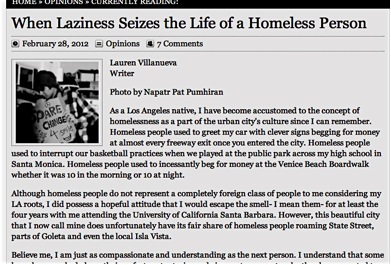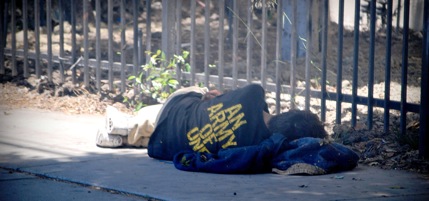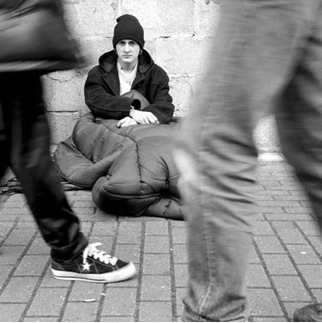Written by Perry Firth, graduate student at Seattle University Community Counseling, and Project Assistant for Seattle University’s Project on Family Homelessness
“I saw an older homeless man ahead of me rummaging through a trashcan, and as I got closer he started to move away from the can and began to scratch his back, his clothes tattered and dirty, wearing navy sweatpants in August. With my walkway right in the center of the six feet of distance between the trashcan and the man, I decided ‘play it cool’ and walk between the two, not wanting to appear as if I was walking 15 feet out of the way to my right to purposely avoid him. Homeless people are everywhere in New York, so I’ve learned to carry about my business and not get so on edge when one wanders into the subway car and sits across from me, not having showered in who knows when.”
The above quote is from a young woman’s travel blog; the post, from last August, was titled “Feelings of Pure Disgust.” I found it when I decided to write a blog post on how general society responds to people who are homeless. I began with this quote because I think it illustrates some common reactions to homelessness — namely, barely concealed disgust, lack of empathy, and a worldview that separates people who have homes into “us” and those who don’t into “them.”
Interestingly, the post has been taken down since I first read it, so I cannot link to it anymore. Perhaps she got some negative reactions to it.
She seemed to be talking about people the same way she would about some sort of nasty pest, rats for example. Try this: “Rats are everywhere in New York, so I’ve learned to carry about my business and not get so on edge when one wanders into the subway car and sits across from me…” Whenever you can substitute an animal for a person in a sentence and have it still work, it is worth reflecting on whether dehumanization is occurring. While neurobiological research into dehumanization can tell us what the brain looks like ‘on bias,’ that still leaves us the question of why some people do it (consciously or not), and others don’t.

Dehumanization is an acquired response; none of us is born viewing some people as less than human. It is also a matter of degree. In its everyday incarnation, dehumanization of those who are homeless might involve crude jokes, or rather than seeing a human being sleeping on the sidewalk, you see merely a form that you have to walk around. Taken to its extreme, however, dehumanization of those unlucky enough to be without shelter can yield devastating results, which I discuss later in this blog.
I know many of us have had the experience of walking somewhere, and encountering someone asking for food or money. Or we see someone who is clearly homeless, and in dire need of basic services. At least for the majority of us, we usually keep walking. Why? What feelings does seeing people who are homeless, specifically individuals who are homeless, bring up for us? What do these emotions mean for advocates trying to both engage and mobilize the public? How can we humanize/put a face to people who are homeless?
Struggling with these questions
I think we can begin to answer the above questions in two ways. First, in a best-case scenario, we continue on because we are too busy, too overwhelmed by the need we see daily, or are desensitized by the suffering we see around us to allow another’s pain to really resonate. In a worst-case scenario (and unfortunately this is not uncommon), we continue on because the person on the street does not seem fully human; they are less than us, tainted, and therefore deserving of barely concealed ridicule, homeless jokes, and certainly not our help. In this worst-case scenario, we perceive their homelessness as their moral failing.
I know that I fall into the category of people whose (lame) excuse is one of busyness and paralysis when I think of the huge need out there. My logic goes something like this: I see that person in clear need. I should stop and help them. What if they don’t want my help? Is this presumptuous? If I help them do I have to help the person next to them? I then feel bad both about the state of the world, my own confusion about what is the right approach, and my ultimate failure to help.
One of my colleagues with the Project on Family Homelessness notes that this is not an uncommon reaction; however, it does unfortunately fall under the category of “feeling good about feeling bad.” It can be an excuse for inaction, lending itself to thoughts like, “Great! I fulfilled my guilt-about-the-state-of-the-world quotient and now can go on with my day having confirmed to myself that I am a good person who feels empathy.”

I share my thought process because I don’t think it is an unusual one, and I also think it acknowledges the reality of the world we live in. Need is everywhere, and it is harder for us to care about strangers in need, in a (somewhat) vast city, than it is about people in our closer community. I would never walk past a neighbor in clear need. I would, and frequently do, walk past people who I don’t know.
The brain process behind “dehumanization”
Dehumanization, covert or openly sanctioned, is in my opinion an act of violence. I feel that it denies the one unifying link of all people: our humanity. This denial reverberates to the point where the person or group in question is perceived to be incapable of feeling the full range of human emotion, or human need. This is why dehumanization is such a potent force. If someone is seen as not fully human, they don’t really need our help or our respect.

It is only in relatively recent history that neurobiological research can speak to the mechanism behind dehumanization. A 2006 Princeton University study, “Dehumanizing the Lowest of the Low: Neuroimaging Responses to Extreme Out-Groups,” asked university students to look at images of different categories of people, as well as objects, so that an MRI could measure brain activation.
The researchers were looking at which parts of the brain light up when we are engaged in social information processing, like recognizing a human face, thinking about people, or thinking about ourselves. What they found revealed what dehumanization looks like on a neurobiological level. In all the participants, when they were looking at the images of various groups, the social thought/people processing parts of their brain lit up. This held true regardless of whether the group they were looking at also brought up some negative emotions (like envy and jealousy ascribed to the wealthy). In this way, the study replicated what the researchers expected it would: when people looked at people, their brains registered that information in areas that process social, human information.
However, there were two groups that in fact did not cause participants’ brains to register “person.” One was the “drug addict” group, and the other was the “homeless” group.
When participants looked at images of both of these groups, very little happened in the social thought areas of their brains. At the same time that the participants’ brains were not registering the people in the photos as human, their amygdalas were unusually active. This has important ramifications because the amygdala is the part of the brain that deals with feelings of fear. These participants also registered high levels of disgust.
What does this really mean, and what could be the potential cause of this? The researchers theorize that people who belong to very marginalized groups, like the homeless, are victims of extreme prejudice, to the point of dehumanization.
This makes sense if you think about it. If someone is not being processed as human, they are viewed in the same way someone would view an object. This is especially scary because it is this same dehumanization and objectification that is seen throughout society.
For example, remember the “wireless hotspot” controversy at the 2012 South by Southwest event? Articles in Psychology Today and other publications used the Princeton research to point out that this promotion was a prime example of dehumanization.

While the participants in the Princeton study probably don’t actively treat those who are homeless poorly, it does mean, especially if this dehumanization is indicative of the general population, that homelessness can bring up intense feelings that aren’t positive, ensuring that acting to end it could be all the more difficult. The general public might not be especially motivated to help people who they not only view as sub-human, but fully responsible for their lack of housing.
Making fun of homelessness – why is it okay?
How do we fight this dehumanization? Every effort must be made to educate people about homelessness, starting from a young age. I continue to feel that making fun of those who are homeless is one of the last accepted forms of bias. And it is going to remain this way until making fun of people who don’t have homes is relegated to the same shameful domain as making fun of someone because of race or gender.
To give you a public example of what an absence of awareness can look like in a very public forum, I will bring up everyone’s favorite televised event, the Academy Awards. The host, Seth MacFarlane, made a joke about the quality of a recent movie he directed, Ted, by saying it is so bad it is being “pissed on by bums in Redboxes outside of grocery stores.” Here you can see the common practice of someone’s extreme misfortune and homelessness as path to humor. So, yes, thanks Seth, let’s make fun of people who don’t have homes with bathrooms, and let’s do so in front of some of the wealthiest, most privileged people in the world.

The deadly result
Dehumanization not only prevents action to help those who are homeless, but can also turn deadly when it is carried to its extreme. Doing research for this blog, I came across a CNN article reporting that since 1999 more than 240 people who were homeless have fallen victim to fatal hate crimes, and 880 have been targets of violence. That is two and a half times higher than hate crimes perpetrated against other groups combined. And there were many more incidents since these reports were published.
These are saddening and frightening statistics, and naturally lead to the question, how do we prevent this from happening?
Time for re-humanization
The answer to me is clear, and as I’ve said, begins with education and raising awareness. Just as children are raised with the understanding that making fun of or thinking less of someone based on race, religion and other differences is wrong, they need to be taught about the societal causes of homelessness, and that making fun of homelessness is equally wrong. This education needs to happen both in the home and in school.
Great examples of curriculum developed to help children and teens gain awareness about the causes of, and misperceptions around homelessness include Kids without homes: A school district responds, and the University of Texas at Austin’s Charles A. Dana Center’s detailed homelessness awareness education planning, as well as resources from the Illinois State Board of Education. The National Center for Homeless Education offers a list of homelessness awareness resources, such as videos, on its site.
I also believe that talking about this issue, like we are doing here on Firesteel, can help to increase society’s awareness about how it responds to its most vulnerable members.
We need to take an honest step back as a society and engage in some collective soul searching. This soul searching might reveal that while we don’t harbor bias, we simply can’t find the time to help those most in need or that we absolve ourselves of inaction through succumbing to the guilty pleasure of feeling good about feeling bad. It may also reveal that some part of ourselves dehumanizes those who don’t have a safe and secure home. In either case, we need to acknowledge that the most vulnerable populations in our society deserve more than our apathy or ridicule.
Have you seen examples of dehumanization? How have you responded?
Pingback: Mad Men, ACEs and Child Homelessness – Escaping the Past Is Not So Easy (Firesteel) | Faith & Family Homelessness Project()
Pingback: Social Media Advocacy: Whose Story Is It Anyway? | Faith & Family Homelessness Project()